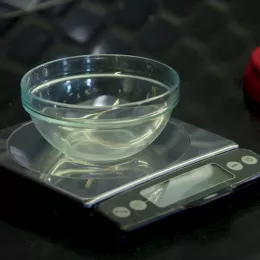ICE chefs Kathryn Gordon and Jeff Yoskowitz recently visited South Korea with ICE alumnus Heejin Lho, who wanted to share with the chefs the traditional foods and culture of her country. While Chef Jeff found his favorite meal (surprisingly) in a food court and learned how to navigate intensely hot kimchis, Chef Kathryn was impressed by the elegant, edible flowers like gardenia and magnolia. Below is a conversation between Chef Kathryn and Chef Jeff that took place during the latter half of their visit.
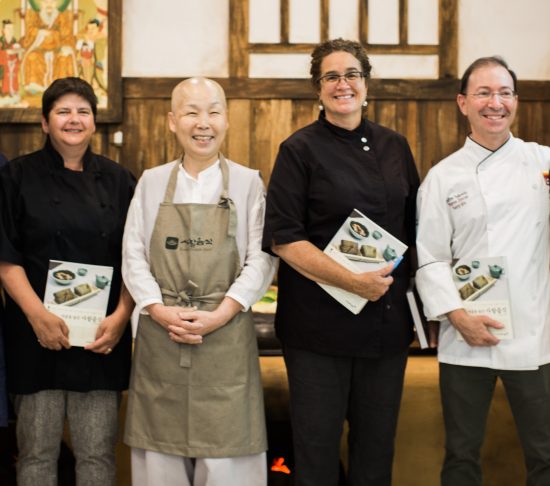
Chef Kathryn: Jeff, to start this off, what have you liked best so far?
Chef Jeff: Many things fascinated me this week. I liked making songpyeon — the half-moon shaped rice cakes made with pine needles and dough from sticky and non-glutinous rice [in the Songpyeon Rice Cakes class hosted by the Tteok (Rice Cake) Museum in Seoul]. The dough was counterintuitive in terms of its dryness level. If it was too wet, you couldn’t form the cakes because it stuck to your hands.

That rice cake dough was amazing because it was colored by fruits, plants or flowers like strawberry, mugwort and gardenia — but the dough didn’t like me! My right thumb just didn’t “get it” in terms of the shaping for the first 15 minutes. Meanwhile, you were the teacher’s pet!
I also really liked our Korean Temple Food center cooking class led by the Buddhist monk. It exposed us to new vegetables and cooking methods, like gingko nuts, lotus leaf, perilla leaf, burdock and acorn jelly. We ate acorn jelly three times this week — I had no idea it was so prevalent! It made me want to track down acorn flour in the U.S. and figure out how to remove the bitterness.
So much flavor came from the lotus leaf, which provides an impermeable layer so whatever you cook in it retains its moisture, while deriving some yellow color and flavor. It was also interesting that the blanched and diced lotus root, which provided texture in the rice, is the root from white flowers, not the pink lotus flowers. I also liked learning about the traditions of mixing sticky and non-glutinous rice.
I loved that in Buddhist temples they eat every part of every plant. We ate a salad made from succulents at The Shilla Seoul hotel banquet. We were exposed to foods that we never knew were foods before.
The organization and customer service at The Shilla Seoul was really impressive, but so was the customer service at the high-end food markets at the department stores. At the Hyundai Department Store, I counted 12 people in front of the wine area alone, just waiting to assist you with selecting wine.
Each area — the fish, the seaweed island or dried roots — had multiple people waiting to help you in your selection and pack it up. I have never seen that level of presentation, care and customer service before.
Heejin carefully selected our menu for the week so we didn’t just taste traditional Korean dishes. What dish did you find the most interesting?
I was a little skeptical when she said we were going to a food court for Korean-style shabu shabu, but the dinner at the Shinsegae Department Store was one of my favorite experiences.
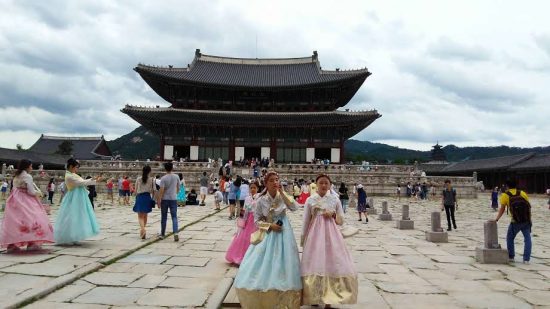
I loved how they made so many dishes from the one base broth. The same broth that cooked the sliced beef was reduced with mushrooms, scallions, cabbage and other vegetables before more meat was added. The broth then reduced a second time while we ate that course, and subsequently it was either used to cook noodles and assorted greens, or to make a thick porridge-like stew with rice and greens.
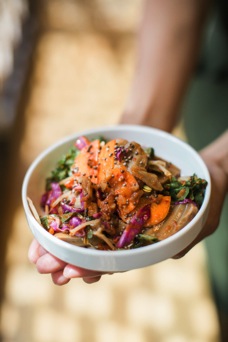
I liked being exposed to edible flowers. I always love cooking with flowers, but never tasted gardenias before this week. When we visited the Tea Story teahouse in Seoul, they had so many teas based on plants and flowers that we don’t typically eat or cook with in American or Western European cuisines, like mistletoe, magnolia and lotus.
And then there’s the situation of trying to order hot tea with a meal — the restaurants we experienced literally did not have any.
We learned that with Korean cuisine, you don’t always drink tea with a meal, like you might at a Chinese or Japanese restaurant.
Yet coffee shops are everywhere and seemingly open at all times. Per capita, there seems to be an extremely high interest in coffee — I counted three coffee places on one city block alone. The availability of coffee is much more noticeable than in New York.
What did you think of the dessert scene in Korea?
I was impressed by how aesthetically clean the cakes and tarts look in every pastry window, and not just in high-end shops and stores — even a chain-style bakery. There is nothing “homey” here, unless you count the fruit.
And the fruits in general are enormous! We’ve never seen such big peaches, apples, figs and grapes. We tried grape tarts one afternoon. We also saw a lot of desserts made with green grapes throughout the week that are not popular in the United States including shaved ice and blended drinks.
What about the kimchi? We ate kimchi made with a lot of greens, cabbage and daikon this week, and were introduced to white kimchi, which I had never had before this trip.
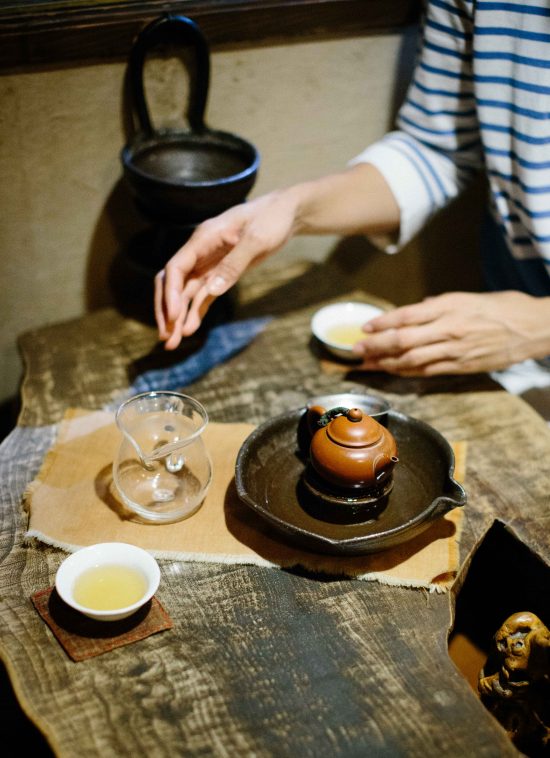
I feel more educated generally about kimchi, although I definitely learned I prefer the garlic (non-Buddhist) style.
In terms of heat and the dishes we’ve eaten with gochujang chili paste — in one meal, your eyes were watering at the end!
There are some hot foods you put in your mouth and then it spreads slowly. Once the heat from the kimchi spread, it was too late for me to do anything about it. I did gain a better appreciation of all the contrasting flavors, and the range of foods to pair with something hot came more easily with practice than in the beginning of the trip.
What else besides food did you find most interesting this week?
As we were driving south through the countryside to Cheolla Province, the sheer mass of vertical apartment building construction was astonishing.
They don’t build one building at a time. We would look towards a range of mist covered forested mountains and see clusters of towers going up simultaneously with cranes on top of each building.
Want to explore the pastry arts with Chefs Kathryn and Jeff? Click here for more information on ICE’s career programs.



